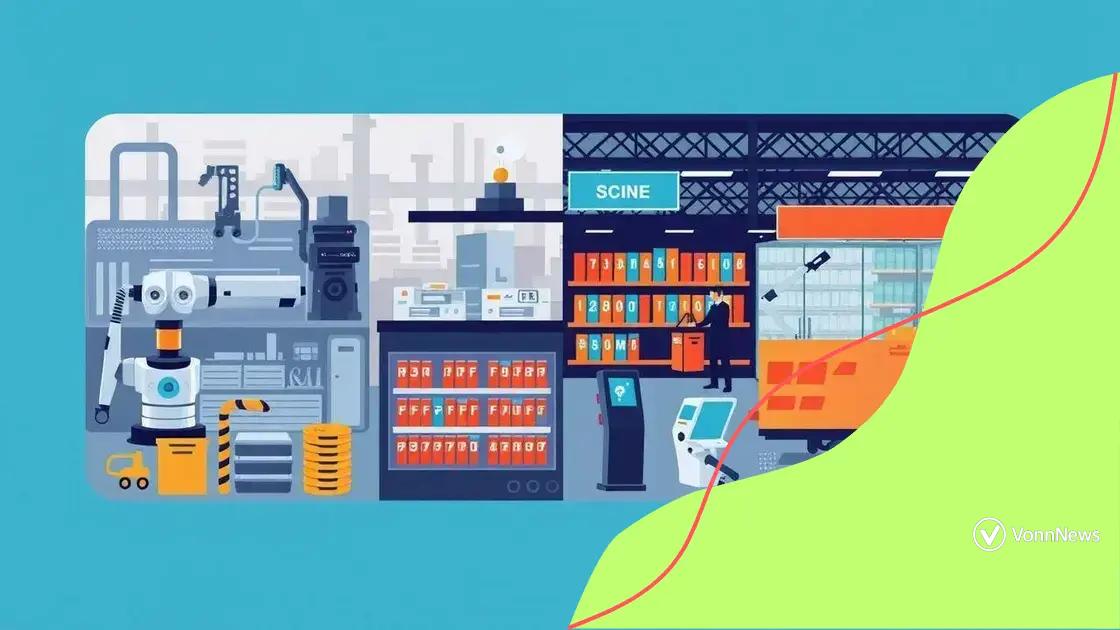Automation and job security concerns: what you need to know

Anúncios
Job security in an automated world depends on adaptability, continuous learning, and collaboration between humans and machines, while investing in skills that complement technology is essential for long-term career success.
Automation and job security concerns are increasingly relevant in today’s fast-evolving workplace. Many wonder how these changes might affect their jobs. Are you one of them? Let’s dive in and unpack these important issues.
Anúncios
Understanding automation and its implications
Understanding automation is crucial in navigating today’s workforce. Automation involves the use of technology to perform tasks that would typically require human intervention. With the rise of automation, many are concerned about its implications for job security. This post will delve into the various aspects of automation and how it may impact jobs.
The role of technology in automation
Technology plays a significant role in automation. From robotics in manufacturing to software that handles data entry, automated systems, in many cases, enhance productivity. However, this also raises questions about the need for human workers in certain positions. As technology evolves, so does the way we work.
Pros of automation
Implementing automation can lead to a variety of benefits:
- Increased efficiency in processes
- Reduction in operational costs
- Higher accuracy and less human error
- Ability to scale operations quickly
These advantages can help businesses grow and adapt in a competitive environment. However, it’s essential to weigh these benefits against potential drawbacks.
Cons of automation
Anúncios
Despite its benefits, automation can cause significant disruptions in the job market. Some challenges include:
- Job displacement for certain skill levels
- Increased need for skilled workers in technology
- Wage stagnation for lower-skilled positions
As firms increasingly adopt automated solutions, workers may find it challenging to keep their roles. This may create feelings of uncertainty among employees.
Many industries are significantly affected by automation, including manufacturing, retail, and customer service. For example, in retail, automated checkouts are becoming more common, reducing the need for cashiers. This change can have far-reaching implications for employment in these sectors.
It’s essential to consider that while automation can potentially displace jobs, it also creates opportunities for new roles. Workers may need to adapt by learning new skills or transitioning into different positions. This need for ongoing education is vital for remaining relevant in an evolving job landscape.
The relationship between automation and job security
The relationship between automation and job security is a complex issue that many workers face today. As businesses seek to improve efficiency, they often turn to automation. This shift brings both opportunities and challenges for employees. Understanding how these changes affect job stability is essential for navigating the modern workforce.
How automation impacts job roles
Automation can transform job roles significantly. It can lead to the enhancement of certain positions by taking over repetitive tasks, allowing workers to focus on more complex duties. However, some roles may become obsolete, creating a ripple effect in employment. Places that depend heavily on routine tasks are likely to see the most significant changes.
Job displacement vs. job creation
While automation may displace some jobs, it can also create new opportunities. The emergence of new technologies often requires a workforce skilled in those areas. For instance, jobs in technology, maintenance, and supervision of automated systems are on the rise. Workers may need to adapt by learning new skills to keep pace.
Many companies invest in training programs to help their employees transition into new roles. This approach demonstrates a commitment to ensuring job security amidst an evolving job landscape. Investing in education allows workers to become more versatile and marketable in their fields.
Worker adaptation and the future of job security
As automation continues to develop, embracing change is essential. Workers may need to be proactive about seeking training opportunities. This adaptability can significantly enhance job security, making employees valuable assets to their organizations. Furthermore, industries such as healthcare and education will still require human interaction, providing stability for those in those fields.
Understanding the connection between automation and job security is vital for workers and businesses alike. Organizations that communicate openly about automation strategies can help ease employees’ concerns, creating a more trusting work environment. With proactive engagement, it is possible to find a balance that maintains both innovation and job stability.
Industries most affected by automation

Industries most affected by automation are experiencing significant changes as technology evolves. As businesses adopt automated systems, job roles and workflows are being transformed. It is essential to understand which sectors are feeling the impact of automation the most.
Manufacturing
The manufacturing industry has seen some of the most dramatic shifts due to automation. Robots and machinery are now responsible for repetitive tasks, increasing efficiency and reducing costs. However, this evolution often leads to job displacement, particularly for workers in assembly line roles.
Retail
In retail, automation is changing the shopping experience. Self-checkout machines and online automated inventory management systems are widely used. While these innovations improve efficiency, they also reduce the need for cashiers and stock clerks, significantly altering employment opportunities in the sector.
Transportation and logistics
The transportation and logistics industries are also being transformed. Automated vehicles, drones, and smart logistics software are streamlining operations. These technologies help companies save time and money, but they can also lead to job losses for drivers and warehouse workers.
Despite job displacement, automation in these industries can create new roles, such as system maintenance and oversight. Workers will need to adjust to the changing landscape by exploring new job opportunities or learning the skills necessary for emerging positions.
Healthcare
Interestingly, the healthcare sector is experiencing a different dynamic. Automation helps with tasks like data entry and patient monitoring. While robots can assist in surgeries, the need for human care remains essential. However, administrative roles may see some reduction.
Furthermore, every affected industry must embrace ongoing training and education to support workers affected by these shifts. This focus on skill development can ensure that employees remain competitive and empowered in a rapidly evolving job market.
Strategies for workers to adapt to automation
Strategies for workers to adapt to automation are essential in today’s changing job market. As technology advances, employees must embrace change to remain relevant and secure in their jobs. Understanding how to navigate these shifts can greatly enhance job stability and career growth.
Continuous learning
One of the best approaches for adapting to automation is committing to continuous learning. Workers can seek out training programs and workshops that focus on new technologies relevant to their fields. These opportunities help develop skills that are in demand, making employees more valuable.
Upskilling and reskilling
Upskilling involves enhancing existing skills, while reskilling focuses on learning new ones. Both are crucial for adapting to automation. Workers should identify areas where automation impacts their roles and pursue relevant educational resources. Some options include:
- Online courses on emerging technologies
- Certification programs in specific software
- Workshops focused on problem-solving skills
By actively pursuing these pathways, workers can ensure they stay competitive and adaptable in the job market.
Networking and building connections
Building a professional network can also facilitate adaptation. Joining industry groups or attending seminars helps workers connect with others and share insights about changes in their fields. Networking can lead to mentorship opportunities, which can provide guidance in navigating career transitions.
In addition to networking, seeking feedback from managers and peers is essential. Constructive feedback can highlight areas for improvement and reinforce a culture of growth. This process promotes professional development and acknowledges the challenges posed by automation.
Embracing technology
Finally, workers should embrace technology rather than fear it. Familiarity with automation tools can lead to enhanced job performance. By engaging with new technologies, employees can streamline their tasks and improve productivity. This positivity around technology fosters a mindset of innovation, encouraging workers to see automation as an ally.
Adapting to automation involves a proactive approach to learning and development. Workers who take charge of their career growth will likely find new opportunities in the evolving job landscape. Opening oneself to change is key to thriving in an automated world.
Future outlook: navigating job security in an automated world
The future outlook for navigating job security in an automated world presents both challenges and opportunities. As technology continues to evolve, understanding how to thrive amid these changes is crucial. Workers and employers alike need to adapt strategies to ensure stability in the job market.
The importance of adaptability
Adaptability is key to maintaining job security. In an automated environment, workers must be willing to learn and evolve. Embracing new technologies and processes can help individuals remain relevant. Those who can adjust their skills and roles will likely see greater job stability.
Collaboration between humans and machines
The future job landscape will likely see more collaboration between humans and machines. Automation can complement human skills, making workplaces more efficient. For instance, while machines handle repetitive tasks, employees can engage in critical thinking and creativity. This shift enhances overall productivity and job fulfillment.
Investing in skills development
To navigate this automated world, investing in skills development is paramount. Employees should focus on acquiring skills that are less likely to be automated, such as:
- Emotional intelligence and interpersonal skills
- Creative problem-solving abilities
- Technical skills related to emerging technologies
Companies can also support their workforce by providing training and development programs. By fostering a culture of learning, organizations can help their employees adapt more effectively.
Furthermore, job security may increasingly depend on a workforce that is willing to shift careers or industries. Flexibility will open doors to new opportunities and help combat job displacement risk within traditional roles. As industries change, the ability to transition into complementary positions will be valuable.
Community support and active engagement in local economies will also prove essential in building a more resilient workforce. Engaging with local workforce development initiatives can help workers navigate the changing landscape while strengthening community ties.
In conclusion, navigating job security in an automated world requires both adaptation and proactive measures. Workers must invest in their skills and embrace technology. By being flexible and continuously learning, employees can secure their positions and even find new opportunities. Employers also play a key role by fostering a culture of growth and offering training. Together, we can create a balanced future where humans and automation work hand in hand to drive progress and innovation.
FAQ – Navigating Job Security in an Automated World
How can workers adapt to automation?
Workers can adapt to automation by investing in continuous learning and upskilling to stay relevant in the changing job market.
What role do employers play in supporting their employees?
Employers should provide training and development programs to help employees embrace new technologies and adapt to changing job demands.
Why is collaboration between humans and machines important?
Collaboration enhances productivity by allowing machines to handle repetitive tasks while humans focus on critical thinking and creativity.
What future skills should workers focus on?
Workers should focus on emotional intelligence, creative problem-solving, and technical skills related to emerging technologies to ensure job security.